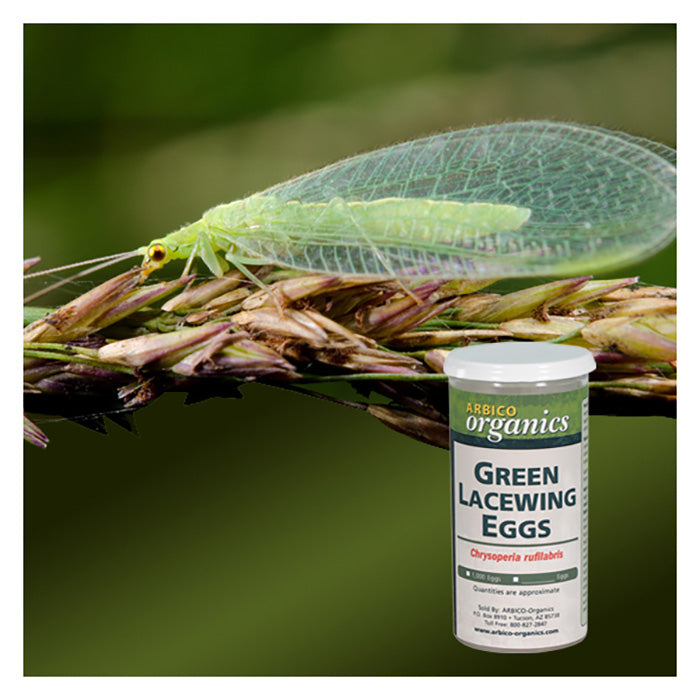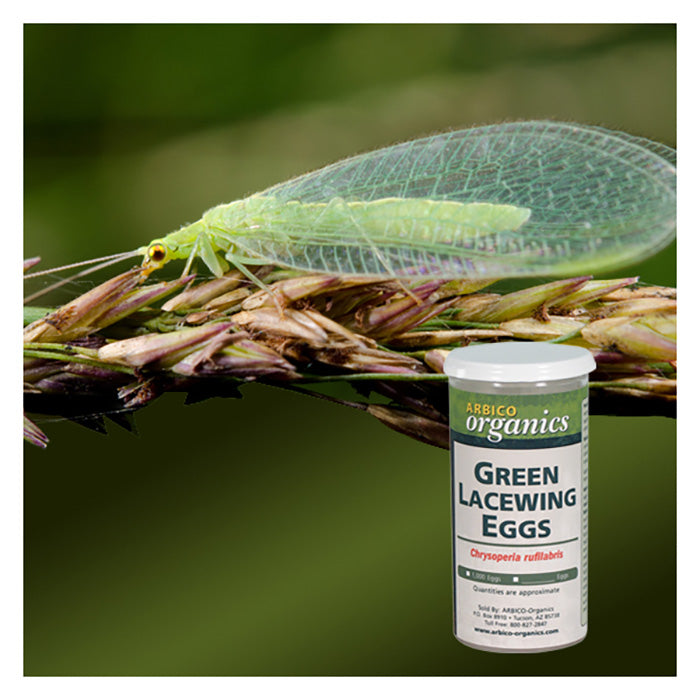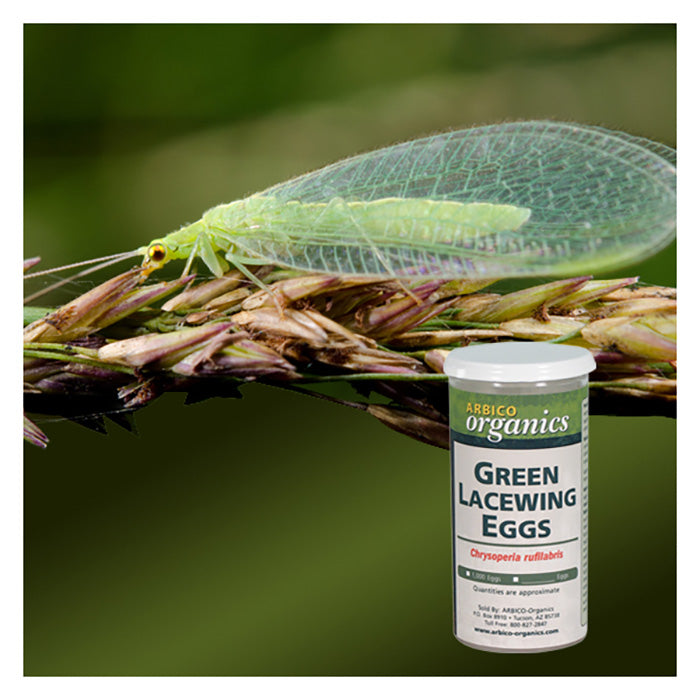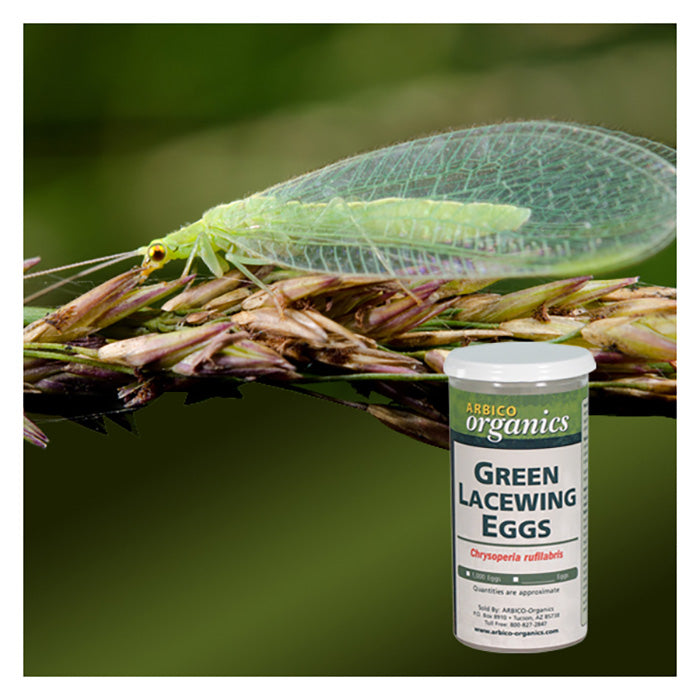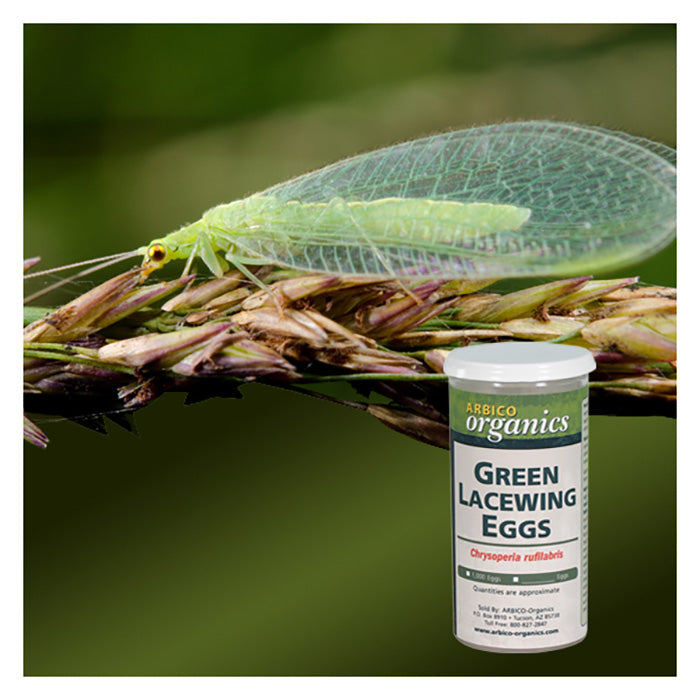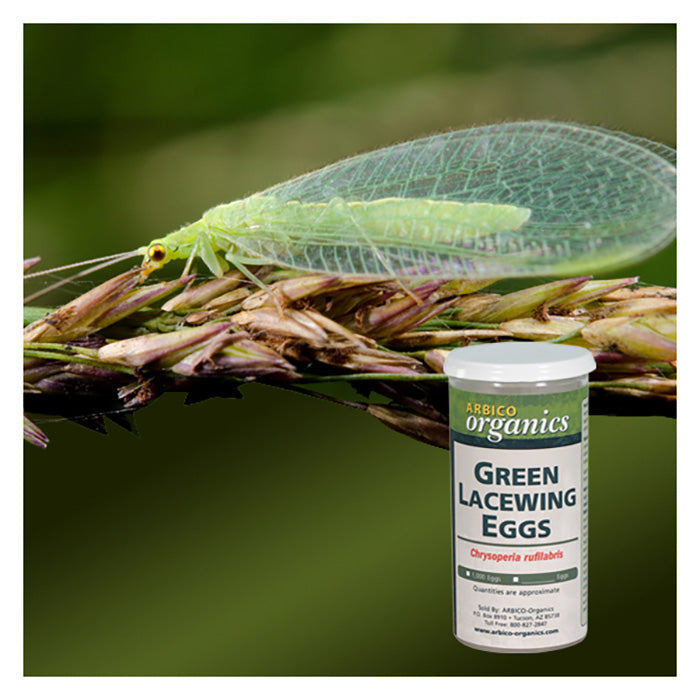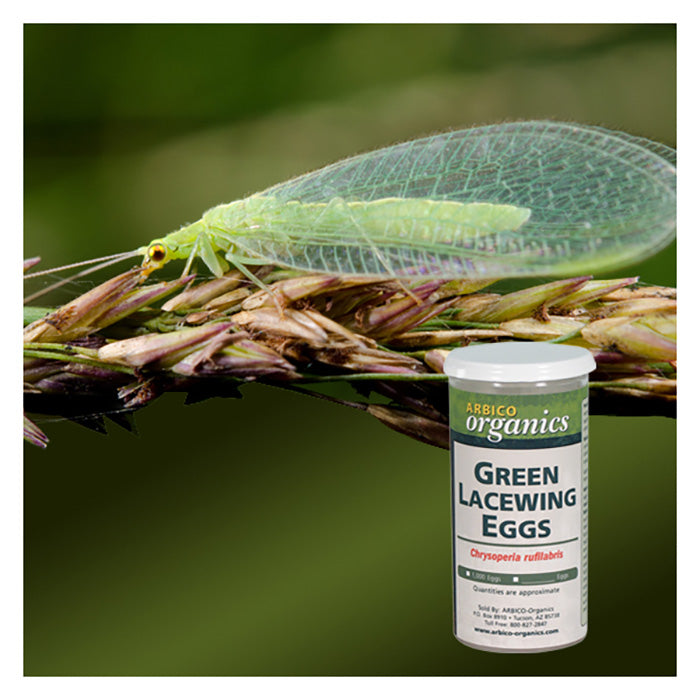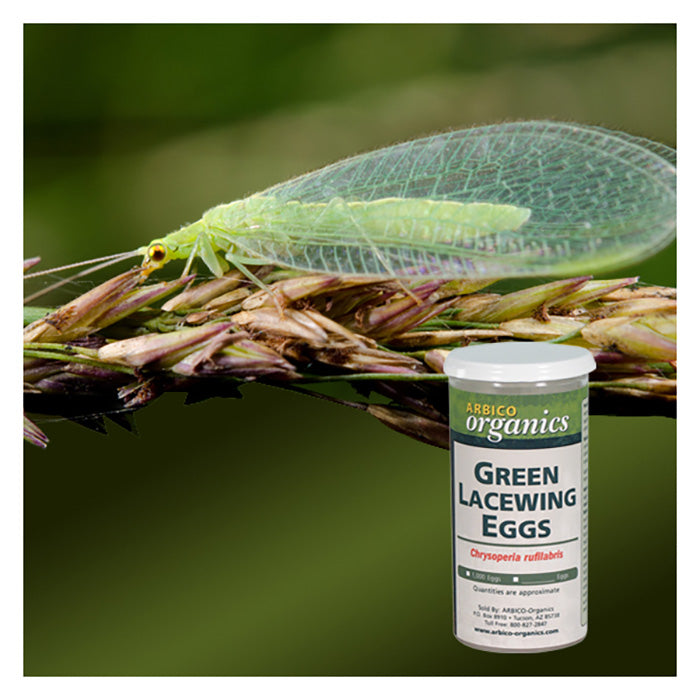ARBICO Organics Product Documents
Green Lacewing Larvae Consume Large Quantities of Aphids, Mites, Thrips, Whitefly & More!
Quantities 1,000-25,000 ship via USPS. Quantities 50,000-250,000 ship via 2nd Day Air. Orders of more than 250,000 may require seven days to fulfill. All orders ship free to the 48 continental US states.
Green Lacewing Preferred Food: aphids, mealybugs, spider mites, leafhopper nymphs, moth eggs, scale, thrips, and whiteflies.
Green lacewing eggs provide the best value among the beneficial insects that ARBICO offers. Once hatched, the larvae are voracious predators used to control a wide range of soft-bodied pest insects. Green lacewing are ideal for building a sustainable population within your growing area for continued control. Lacewings are preferred to ladybugs in many climates due to their ability to survive a larger temperature and humidity range while controlling many of the same pests.
What's In The Package: Green lacewing eggs are mixed in with wheat bran as a medium.
Optimal Temperatures: 67-90°F, RH >30%
Life Cycle & Behavior: Lacewing eggs hatch within 3-10 days of receipt depending on temperature and humidity in the release area. Once hatched, lacewing larvae feed for 2-3 weeks on a variety of soft-bodied insects. Larvae are recognizable by their prominent mandibles (mouthparts), alligator-like appearance and pale coloration with dark markings. The larvae molt as they grow and mature through 3 instar stages. Pupation occurs in silken cocoons on the undersides of leaves or under loose bark. Green lacewing will overwinter in the pupal stage in cooler climates. Adults emerge from the cocoons with large veined ("lacy") wings ready to mate and lay more eggs. Adult green lacewings feed on pollen, nectar and honeydew while aiding in pollination. The complete life cycle lasts roughly 30 days.
Release Rates: For best results, release Green Lacewing early in the season when pest numbers are low. Make a minimum of three releases.
- In gardens and greenhouses, release eggs at approximately 1,000 eggs per 2,000 sq. ft.
- For single shipments of less than 5,000 eggs, please call 1-800-827-2847
- For farms release 5,000 to 50,000 per acre depending upon infestation.
PLEASE NOTE: Ants and aphids have a symbiotic relationship. This is due to the fact that ants value the secretions of the aphids (honeydew) as a food source. The ants aggressively protect the aphids from other insect threats and the aphids produce the honeydew they crave. For this reason, before you begin any treatment to control aphids with predatory insects you will need to eradicate the ants in the area to be treated. Otherwise, they will wipe out any beneficials you introduce.
Instructions
Release Instructions:
Mist down plants lightly before releasing green lacewing. Gently shake the vial containing the lacewing eggs and bran. Tap contents out onto foliage. Distribute as evenly as possible throughout the affected area. If you have noticed ants in the growing area or nearby pest populations (mainly aphids and scale) you may want to hang a Dixie cup or paper coffee filter with a small amount of lacewing eggs within the plant canopy. This will keep the eggs separate from the ants and ensure predation does not occur.
What Should I Expect After Release?
Green lacewing eggs will hatch within 3-10 days of receipt. Lacewing larvae are difficult to spot once hatched out and camouflage well with their surroundings. You can inspect eggs for hatching by looking for color changes. If eggs are still green, lacewing larvae are still developing. If eggs are gray, the larvae have hatched out.
Keep in mind that beneficial insects work at a slower pace than chemical controls. If immediate knockdown or control of an insect population is necessary, consider spraying a fast-acting insecticide or select a more targeted predator/parasite.
Adults lay eggs near larval food sources, so adult activity will be higher in those areas. They will appear around one month after release of the eggs and tend to disperse if food sources are limited. Providing plants that bloom and pollinate at different times of the year helps cultivate a habitat suitable and attractive to the adult green lacewings.
Environment: Aquaponics, Container Plants, Farms, Gardens, Greenhouses, Grow Room, Hydroponics, Indoor Growing, Interiorscapes, Nurseries, Orchards, Outdoors, Row Crops, Vineyards
Storage: Do not store.
Technical
Warning & Toxicities: Use caution in handling if you have wheat allergies.
Shelf Life: Eggs will hatch within 3-10 days of receipt at 75-90°F.
This Product Controls These Pests or Diseases: Alfalfa Weevil (Hypera postica Gyllenhal), Aphids (Mult),Armyworms (Pseudaletia unipuncta), Asparagus Beetles (Crioceris asparagi (common); Crioceris duodecimpunctata (spotted)), Bean Beetles - Mexican Bean Beetle (Epilachna varivestis Mulsant), Bean Thrips (Caliothrips fasciatus), Beet Armyworm (Spodoptera exigua (Hubner)), Beet Leafhopper (Circulifer tenellus), Black Scale (Saissetia oleae), Brown Almond Mite (Bryobia rubrioculus), California Laurel Aphid (Euthoracaphis umbellulariae), Caterpillar Eggs (Mult), Citrus Red Scale (aka California Red Scale) (Aonidiella aurantii), Citrus Yellow Scale (aka California Yellow Scale) (Aonidiella citrina), Coconut Mealybug (Nipaecoccus nipae), Colorado Potato Beetle (Leptinotarsa decemlineata), Grape Leafhopper (Erythroneura elegantula), Greenhouse whitefly (Trialeurodes vaporariorum), Leafhoppers (Empoasca sp), Mealybugs (Pseudococcus sp), Mexican Bean Beetle (Epilachna varivestis Mulsant), Mites (Tetranychus sp), Oleander Scale (Phenacaspis sp), Potato Leafhopper (Empoasca fabae), Potato Leafhopper; Bean Jassid (Empoasca fabae), Psyllids (Mult), Scale (Mult.), Silverleaf whitefly (Bemisia sp), Spider Mites (Mult), Sweet Potato Whitefly (Bemisia tabaci), Thrips (Franklinothrips sp), Tobacco Budworm (Heliothis virescens), Two-Spotted Spider Mite (Tetranychus urticae)
| Brand | ARBICO Organics |
|---|---|
| SKU | ARBO-LWEGGS |
| Hazardous Material | false |
